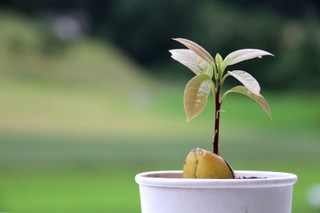How to grow avocados indoors

Oh, the elusive and seductive avocado. Who hasn’t seen an avocado pit on toothpicks dangled over a cup of water and wondered, “does that work” or “can you grow a tree that way?” The answer is yes; it is possible to sprout an avocado seed at home using that method. With dedication and care, that sprout can grow to a tree that bears fruit one day.
Avocado trees (Persea americana) are grown indoors in all USDA growing zones, making great houseplants, whether or not they bear fruit. They can be started from seed, or juvenile trees can be purchased from a retailer. When grown indoors, they do best in a south or west-facing window where they receive a minimum of six hours of sunlight, and temperatures are between 60 and 85℉. Avocados like dry soil and high relative humidity.
Trees grown from seed take about ten years to start producing fruit. Purchased trees may bear fruit in as little as three or four years.
The truth is, the odds of an indoor avocado bearing fruit are not great. It is by no means impossible, but it won’t be a quick task. Getting an avocado tree to fruit is a long-term commitment and how long it takes for indoor plants to bear fruit depends significantly on the growing method used and the care provided to the tree.
However, if you are patient and take care of your tree correctly, you will be rewarded in time with the rarest of homegrown fruits, avocados. Which anyone would agree is well worth the effort.

When will my avocado bear fruit?
There are two ways you can grow an avocado tree – either from an avocado pit harvested from a grocery store avocado or by purchasing nursery stock. Avocados grown from seed will not bear fruit until they are at least a decade old. Trees planted from a nursery will begin fruiting much more quickly, beginning at about three or four years old.[1]
Nursery-grown avocados are not grown from seed but are cloned or propagated from mature trees, which is how they develop so much quicker.

The enthusiast's guide to herbs
We’re proud to present our new e-book, The Enthusiast’s Guide to Herbs! Learn everything you need to know about growing and caring for herbs indoors, including in-depth info cards for the 35 most commonly grown herbs.
Click the link below to find out more!
How to grow an avocado indoors
How you decide to start your avocado tree is personal preference; each choice has advantages and disadvantages. Seed-grown trees will take longer to develop but are much cheaper to start. Nursery-grown avocados mature much quicker but are considerably more expensive to purchase, though.
While it may be tempting to go straight to a nursery-grown avocado, consider growing one from seed first to learn how to care for a tree.

Supplies
With a few basic supplies – which you may likely already have – it is easy to get started growing your own avocado tree indoors. Very simply, you’ll need a container, potting soil, and either a seed to start your plant or a juvenile plant from your local nursery.
- A container with good drainage. For starting a seed, look for one like this terracotta clay pot with drainage hole and saucer at Amazon that is at least 10” in diameter. If you purchase a tree, look for a container slighter larger than the pot it is in. Terra cotta works well since it’s a porous material. The improved air circulation through the roots helps the potting mix dry out quicker, keeping the substrate from being saturated for long periods and damaging the shallow roots.
- Growing media to fill the container. An Organic Cactus and Succulent Potting Mix at Amazon is ideal. These products are formulated to be loose, fertile, and quick-draining for plants preferring drier soil conditions.
- An avocado seed out of fruit from the grocery store or an avocado plant purchased locally or online. A couple of different cultivars are available for purchase, but dwarf varieties (i.e., Wurtz) do best inside.
Growing an avocado from seed
Starting a tree from the seed of an avocado is an easier DIY project than most people imagine. It is similar to rooting cuttings in water and requires very little in terms of supplies. The important thing to remember is if nothing has happened after eight weeks, toss your seed out and try sprouting another one.
- The first thing to do is to rinse the seed clean.
- Poke three toothpicks around the seed, spacing them as evenly as possible so you can suspend the avocado over a glass of water. Submerge the broad end of the seed about an inch in the water, with the top exposed to air.
- Place the glass in a warm spot out of direct sunlight. Avoid a windowsill since too much light can cause bacterial growth in the water.
- Change the water in the glass every couple of days.
- When the stem is between six and seven inches long, cut it back to three inches and wait for it to sprout leaves.
- Once you have dense roots and healthy-looking leaves, it’s time to transplant into a pot that is ten inches or larger in diameter with adequate drainage holes.
- Loosely fill the pot almost to the top with the potting mix and hollow out a hole deep enough for the avocado seedling’s roots.
- Spread the roots out and gently pack soil around the pit, leaving the top of the seed above the soil line.
- Water gently until water runs from the drainage holes.
- After the excess water drains out, place the pot in a drainage dish and set it in a south-facing window.
Growing an avocado from a young tree

Growing an avocado tree purchased from a nursery or online is obviously easier than growing from seed. When you buy a small tree and bring it home, give it a couple of weeks to acclimate to the indoor conditions before transplanting it to a new container. Moving it too early will cause transplant shock.
- Put a couple of inches of potting soil in the bottom of the container.
- Lay the avocado tree on its side and gently remove the plastic pot.
- Inspect the root ball. Look for dead or rotting roots, removing them with sharp, clean scissors.
- Gently tease the roots if the plant looks root-bound, being careful not to break any. Avocado roots are brittle, so it’s best to avoid disturbing the roots unless necessary.
- Set the plant on top of the potting soil in the container.
- Begin filling the space around the root ball with potting soil, gently tamping it down as you work until the soil level matches the level in the original container.
- Water the plant well.
- Add additional potting soil if it settles during watering.
- Place the tree in a sunny location with a drainage dish under the container.
Avocado plant care
Growing an avocado tree indoors takes a little more work than your typical houseplants. Overall though, they aren’t high maintenance plants. Native to Mexico and south to the Andean region, avocados trees need plenty of light and warm temperatures to thrive. Care must be taken not to overwater your tree while maintaining a high humidity level for the foliage.
Light
Avocados enjoy full sun and need a minimum of 6 hours of sunlight when grown indoors. Find a spot where they can bask in sunlight from a south or west-facing window for the best sun exposure. In the winter months, when the sun’s rays aren’t as strong, they may benefit from a bit of supplemental light.
Temperature
Your tree will do best in warm temperatures, between 60 and 85 degrees Fahrenheit. This is what makes them excellent indoor plants – they like the same room temperatures as people. During winter months, keep them away from drafty windows or frequently opened doors that let in cold air; in the summer, don’t set them close to an air conditioning vent.
Water
The best method for watering an avocado plant is to do a deep soak once a week or as soon as the leaves show signs of wilting during the growing season. Water until it drains out the bottom of the container. Be careful not to overwater. It’s the number one problem with avocado trees, especially as the tree is getting established.
During the winter months, your tree may need less water as growth slows a bit, and the water in the soil evaporates more slowly in cooler months. Make sure the soil is dry before watering, or wait until the leaves droop a bit. Yellowing leaves are usually a sign of overwatering. If it looks like your avocado tree is yellowing, let it dry out for a few days.
To avoid mineral buildup in the soil from your tap water, use rainwater to water your avocado tree or periodically flush the soil with distilled water. If the leaves are turning brown and curling/drying at the tips, there is likely salt accumulation. Let distilled water run freely into the pot (over a sink) while it drains continuously for several minutes.
Humidity
Avocado trees benefit from higher humidity leaves than are found inside most homes. To increase the humidity level, you can mist the leaves on your tree periodically, group plants together, or set a pebble tray filled with water underneath the container. Just make sure there is good air circulation through the leaves and between plants.
Fertilizing
In the first year of an avocado tree’s life, a fertilizer for citrus trees can help it get established. Or you can use a 10-10-10 fertilizer that contains six percent magnesium. Apply as directed every couple of months for the first year, ensuring not to fertilize too frequently or heavily.
Your tree will also benefit by spraying it with a foliar fertilizer containing copper, zinc, manganese, and boron (trace elements) every couple of months in spring and summer until it matures enough to bear fruit. When your tree begins to set fruit, increase potash fertilization to fifteen percent.
Pruning
Cutting back plants can feel mercenary, but the truth is that it stimulates bushy new growth that is more robust than single-stemmed growth. Always use tools that are sharp and clean to avoid introducing bacteria or disease. Prune to shape the tree the first year, then maintenance prune in autumn or winter when growth is slower.
When an avocado seedling reaches twelve inches, trim the tip and top leaves off, cutting just above a growth node. This will encourage healthy lateral growth. Once lateral stems are six to eight inches long, trim the new growth at the tips off.
After the general shape is established, you’ll want to prune the tree lightly as needed. Remove any branches developing low to the container, and prune out anything dead. If the tree’s center becomes thick, remove “windows” to increase air circulation through the middle.
Staking
Once a seedling is over two feet tall, staking it will help to support its weight and keep the stem from bending over or snapping. A piece of bamboo makes a perfect stake, just drive it into the soil near the base of the plant and tie the stem loosely with a twist-tie or piece of twine.
Moving potted avocados outdoors

If you live in a climate where summers are warm and sunny, you should be able to set your avocado trees outdoors through the warmer months. Acclimate the tree by first placing it in an outdoor location that receives filtered sunlight. After a day or two, move it to a full sun spot, and your tree should thrive.
When the tree is outdoors, pay closer attention to soil moisture, as the soil can dry out much faster in the open air.
Pest & Disease problems
A few fungal diseases and pests can affect an avocado tree, none of which are prevalent. Still, it’s critical to check your tree regularly for any signs of pests or diseases. If you detect anything afflicting the leaves or fruit of your avocado tree, it’s critical to diagnose and treat the issue as soon as possible.[2]
Harvesting fruit
Unlike many fruit trees, avocados won’t ripen on the plant. When avocado fruits reach a mature size, pick one and let it sit for a few days.[3] If it shrivels up or never softens, it isn’t time to harvest. Continue picking a fruit every few days until they ripen. Then pick as you desire, leaving unwanted fruits on the tree.
FAQ
Why are the leaves turning brown on my avocado tree?
The leaves on your avocado tree are most likely turning brown because of inadequate soil moisture or an accumulation of salts in the soil. Make sure you are watering the tree properly, thoroughly soaking the soil when it is dry, and the leaves begin to droop or wilt. Use rainwater if possible, or periodically flush the soil with distilled water to push the accumulated salts out of the container.
How do you save an overwatered avocado tree?
If your avocado tree was overwatered, the first thing to do is hold off on watering until the soil has dried out completely. Move your tree to a spot in your home where it is out of direct sunlight but still receives filtered or diffused light. You can also repot the tree in new potting soil. If there are any signs of root rot, prune off any dead or dying roots before repotting.
How do you get rid of bugs on an avocado tree?
Indoor avocado trees may experience problems with common houseplant insects, including aphids, thrips, and spider mites. Unlike outdoor trees, they don’t typically have trouble with caterpillars, borers, or lace bugs. If you notice insects on your tree, spray the tree (and neighboring houseplants) with insecticidal soap or horticultural oil. Avoid using chemical pesticides inside your home unless necessary.
Why is my avocado tree dropping fruits?
When your plant begins to produce fruit, it may set a huge number and then drop a large number of these fruits. Don’t panic—this is perfectly normal. Your tree may have produced more fruit than it can support, or the fruit may have weak seeds. A sudden drop of all fruits usually signifies a more significant problem such as water stress.[4]

Join our email club—get printable info cards free!
Sign up to receive our newsletter and get access to 10 printable plant info cards from our e-book for free. Also receive:
- $4 discount code for our Guide to Herbs e-book
- Semi-weekly plant inspiration & bite-size tips and tricks
California Avocado. 2020. “How to Grow Your Own Avocado Tree.” Published July 23, 2020. ↩︎
Plant Village. n.d. “Avocado.” Accessed August 16, 20201. ↩︎
Nesbitt, Monte, Larry Stein, and Jim Kamas. 2015. “Avocados.” Texas A&M AgriLife Extension. ↩︎
UCCE Master Gardeners of Orange County. n.d. “Avocados—This year my avocado suddenly dropped all its immature fruit.” Accessed August 16, 2021. ↩︎
